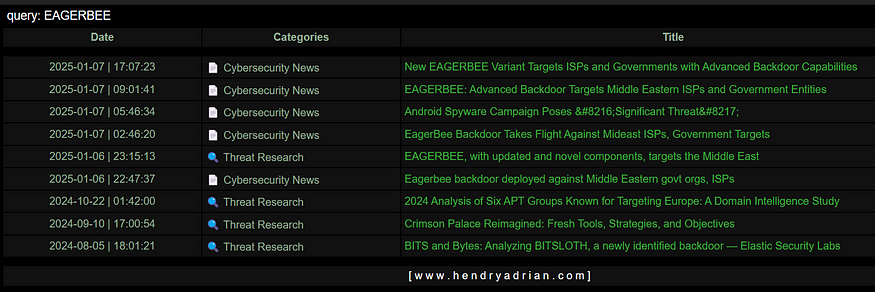
In an increasingly complex digital landscape, the emergence of various types of malware continues to be a significant concern for internet users. One such malware that has recently captured widespread attention is EAGERBEE. Known for its sophisticated capabilities, EAGERBEE has become a hot topic among researchers and cybersecurity professionals alike.
This article provides an easy-to-read overview of EAGERBEE, highlighting the latest updates, key research findings, and the features that make it particularly concerning. By understanding EAGERBEE in a simplified way, readers can stay informed and better protect themselves from potential threats. Let’s dive into the world of EAGERBEE and discover how to safeguard our digital security.

Keypoints
- EAGERBEE backdoor deployed within Middle Eastern ISPs and government entities.
- Utilizes a service injector to compromise running services.
- Deploys plugins for diverse functionalities post-installation.
- Attacks initially compromise systems through an unknown vector.
- Key plugins include File Manager and Process Manager.
- Exploits ProxyLogon vulnerability in Exchange servers in East Asia.
- Abuses legitimate services for malicious DLL loading.
- Stealth techniques hinder detection by injecting code into legitimate processes.
- Evidence suggests a link between EAGERBEE and the CoughingDown threat group.
>> https://www.hendryadrian.com/?p=38206
>> https://www.hendryadrian.com/eagerbee-with-updated-and-novel-components-targets-the-middle-east/
Understanding the EAGERBEE Malware: A Threat to ISPs and Government Entities
In the ever-evolving landscape of cybersecurity, advanced malware threats pose constant challenges. One such threat is the EAGERBEE malware framework, recently identified as targeting Internet Service Providers (ISPs) and governmental entities in the Middle East. This updated variant boasts sophisticated capabilities for system manipulation and remote access, raising significant concerns among cybersecurity experts.
The EAGERBEE Framework
The EAGERBEE malware framework has undergone significant evolution, incorporating various plugins designed to enhance its functionality. These plugins enable the malware to execute commands, manage processes, and exfiltrate sensitive information from compromised systems. Operating primarily in memory, EAGERBEE evades traditional security solutions, making detection and prevention increasingly difficult.
Cybersecurity researchers have linked EAGERBEE to multiple threat actors, most notably the CoughingDown group. This connection points to a complex web of cyber espionage activities, with potential implications far beyond the initial targets. The CoughingDown group, known for its sophisticated tactics, has been associated with various high-profile attacks in the past.
Recent Tactics and Exploits
Recent EAGERBEE attacks have exploited vulnerabilities such as ProxyLogon, facilitating backdoor deployment and unauthorized access to sensitive networks. The malware employs advanced techniques like DLL hijacking to gain initial access, deploying malicious payloads stealthily. A specialized module within EAGERBEE, labeled ssss.dll, orchestrates plugins for file manipulation, process management, and remote access, further amplifying its capabilities.
Experts have identified overlaps between EAGERBEE and previous malware frameworks associated with state-aligned actors, particularly from Chinese cyber units. These findings underscore the geopolitical dimensions of the threat landscape.
EAGERBEE Malware: Unveiling a Growing Threat in Cyber Espionage
The EAGERBEE malware represents a significant threat within the domain of Advanced Persistent Threats (APTs). Recent attacks have targeted Southeast Asian governments and European foreign affairs ministries, with evidence pointing to the involvement of the BackdoorDiplomacy group, suspected to operate from China. This malware’s advanced capabilities make it a powerful tool for cyber espionage, underscoring the persistent challenges nations face in safeguarding their digital infrastructure against sophisticated cyber attacks.
EAGERBEE Malware: A Catalyst for Sophisticated Cyber Attacks
In late 2023, EAGERBEE resurfaced with advanced tactics designed to evade detection and enable deeper reconnaissance of compromised systems. Threat actors leveraged credentials stolen from unmanaged devices to re-infiltrate previously compromised web application servers. Using these credentials, they executed commands that included injecting a Havoc DLL masquerading as a PDF into legitimate Windows processes. This allowed for seamless Command and Control (C2) communications with attacker-controlled servers.
This sophisticated malware not only established remote connections but also collected critical information about security policies and exclusions in configurations of Windows Defender and Sophos. Such insights enabled EAGERBEE to block telemetry and updates, enhancing its stealth. These activities highlight the persistent threat posed by EAGERBEE and the ongoing challenges organizations face in securing their digital environments.
>> https://www.hendryadrian.com/crimson-palace-reimagined-fresh-tools-strategies-and-objectives/
EAGERBEE and BITSLOTH: The Evolving Arsenal of Cyber Threats
The recent discovery of BITSLOTH malware during an intrusion into the Foreign Ministry of a South American government echoes the sophisticated tactics observed in EAGERBEE. Detected on June 25, 2023, BITSLOTH employed techniques such as shellcode injection via the RINGQ tool to bypass traditional security measures reliant on hash blocklists. The malware was further obfuscated through side-loading, utilizing a legitimate application, FL Studio.
The latest BITSLOTH variant introduced a scheduling component aligned with EAGERBEE’s operational strategies, showcasing the increasing complexity and shared functionalities among modern malware families. These developments emphasize the urgent need for vigilant and adaptive cybersecurity measures to defend against multi-layered malware threats.
Recommendations for Protection
To mitigate the risks posed by EAGERBEE, cybersecurity professionals recommend:
- Patch Known Vulnerabilities: Address vulnerabilities such as the Microsoft Exchange ProxyLogon flaw promptly.
- Implement Robust Security Measures: Employ advanced endpoint protection solutions and real-time monitoring.
- Enhance Detection Capabilities: Use tools capable of identifying memory-resident malware and anomalous network behavior.
- Adopt Proactive Threat Intelligence: Stay informed about the latest threat actor activities and evolving tactics.
As threat actors continue to refine their methods, maintaining vigilance and implementing proactive defenses are essential to safeguarding sensitive information and ensuring the integrity of digital infrastructure.
Other References
>> https://www.hendryadrian.com/android-spyware-campaign-poses-significant-threat/
>> https://www.hendryadrian.com/eagerbee-backdoor-takes-flight-against-mideast-isps-government-targets/
>> https://www.hendryadrian.com/eagerbee-backdoor-deployed-against-middle-eastern-govt-orgs-isps/
